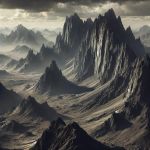Khargaath Range
Overview
The Khargaath Range is a **formidable mountain range** located to the **west of the Citadel Mountains** in the realm of Terasil. These treacherous peaks form the **western edge of Sanctuary Vale**, and they are known for their sharp cliffs, deep ravines, and jagged terrain. The mountains are remnants of **ancient volcanic activity**, and their harsh environment has made them largely impassable to most forms of travel. The town of Djes-Val is located on the eastern slopes, offering a safe haven from the dangerous surroundings.
Etymology
The name "Khargaath" is believed to derive from an ancient word meaning **"remnants of fire"** or **"burned earth"**, a reference to the volcanic origins of the range. The Orasians see the Khargaath Range as a boundary, both **geographically and spiritually**, marking the limits of the **Sanctuary Vale** and the entrance to more hostile lands.
Geography
The Khargaath Range stretches from the **western edge of the Citadel Mountains** to the arid stretches of the **Zanarak Desert**. The range is marked by **steep cliffs, deep ravines**, and **treacherous slopes**, making passage difficult. The **volcanic roots** of the range are evident in the **blackened rock faces** and **sharp spires** that dominate the landscape. Due to the rugged terrain, the range serves as a natural **barrier**, separating the more fertile areas of Terasil from the harsher, desert-like regions to the west.
- Major Peaks: The highest peak in the Khargaath Range is Mount Kharth, rising to approximately 13,000 feet. Other notable peaks include **Grimspire** and **Fireclash Peak**, each representing dangerous and hard-to-reach locations.
Geology
The Khargaath Range is a product of **ancient volcanic activity**, which shaped the mountains' jagged features and mineral-rich landscape. The range is primarily composed of **basalt** and **obsidian**, remnants of the eruptions that formed the range millions of years ago.
- Volcanic Origins: The range’s volcanic past is evident in the **dark, glassy stone** that covers much of the terrain. The minerals present in the range are rich in **iron, sulfur**, and **obsidian**, making the region dangerous and inhospitable for most life forms.
- Geological Formation: The range's complex geology consists of **igneous rock**, **basalt formations**, and **collapsed calderas**, creating a highly unstable terrain prone to rockslides and sudden shifts.
Climate
The climate in the Khargaath Range is **harsh and unforgiving**, with temperatures varying greatly between day and night.
- Lower Slopes: The lower slopes experience a **cool, arid climate**, with occasional storms and high winds. Vegetation is sparse, and only the hardiest plants and shrubs can survive in this environment.
- Higher Elevations: As one climbs higher into the range, the climate becomes **colder and more extreme**, with **fierce winds**, snow, and the occasional volcanic ash cloud. The peaks are often covered in a **thin layer of snow** year-round, and visibility can be poor due to frequent storms.
Ecology
Despite its treacherous environment, the Khargaath Range supports a limited but unique ecosystem. The flora and fauna here are specially adapted to survive in the harsh, rocky landscape.
Flora
Vegetation in the Khargaath Range is scarce but highly adapted to the rocky terrain.
- Ashbloom – A hardy flower that grows in volcanic soil, its petals turn dark red when exposed to volcanic ash. It is used by the Orasians in ceremonial rituals.
- Kharthbrush – A spiny shrub that thrives in rocky crevices, its roots burrow deep into the stone to access moisture.
- Firegrass – A tough, fire-resistant grass that grows in the lower, arid slopes of the range. It is often used by the Orasians in the construction of **ritual fires**.
Fauna
The wildlife in the Khargaath Range has evolved to survive in the **rocky, volcanic environment**.
- Stoneclaw Wolf – A wolf-like creature with **crystalline claws** that can easily scale the rocky cliffs. Known for its stealth and ability to blend into the terrain.
- Emberdrake – A small, dragon-like creature that can expel small bursts of fire. It is often found in the higher elevations of the range.
- Khargaath Bison – A hardy creature that roams the lower slopes, with thick fur and strong hooves that can navigate the rugged terrain.
Cultural Significance
The Khargaath Range holds significant cultural value for the Orasians, who view it as a **spiritual boundary** between the **fertile lands** of Terasil and the harsh, unknown regions to the west.
- Sacred Sites: The Orasians consider the **volcanic remnants** and **deep ravines** of the Khargaath Range to be sacred. The **volcanic craters** are believed to be places where the **Great Consciousness** first took form.
- Festivals and Traditions: The Orasians celebrate the **Festival of Fire**, which marks the beginning of the mining season and honors the volcanic spirits believed to reside within the mountains.
Legends and Lore
The Khargaath Range is rich in **myths and legends**, particularly about the **volcanic spirits** and the ancient rulers of Terasil.
- The Spirit of Mount Kharth: According to Orasian legend, the spirit of **Mount Kharth** is a mighty fire deity that watches over the range. It is said that when the mountain erupts, it is the **spirit’s anger** against those who seek to exploit the land’s resources recklessly.
- The Lost Kingdom of Kharth: There are tales of a long-lost civilization that once flourished in the shadow of Mount Kharth, leaving behind **forgotten temples** and **mysterious artifacts**. Many adventurers have attempted to uncover its secrets, but none have returned.
See Also
Gallery
-
Khargaath Range - A view of the jagged volcanic peaks.
-
Djes-Val - The town nestled at the eastern slope of the Khargaath Range.

